Seriously, I really need to stop doing titles like that…
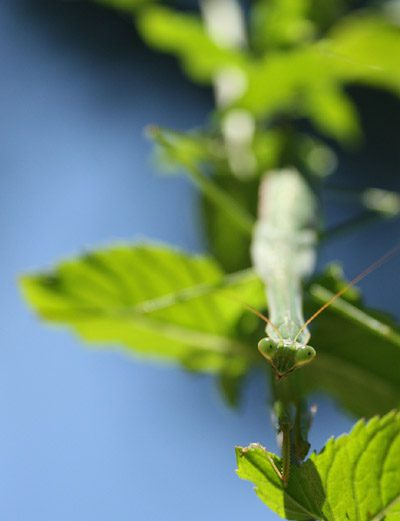 This is going to be the longest post on the blog. Not in terms of words, but in terms of images, since I am going to show a long sequence from the other evening, and they’re nearly all vertical format, so the linear dimensions of the post are going to be exceptional. This may result in some gaps between text blocks, so please excuse the formatting. Plus, this will easily be the most images for a single post, and by itself will exceed the uploads for many previous months. And, this is about the mantids, again. But don’t go yet, because you may never have seen this, or anything like it.
This is going to be the longest post on the blog. Not in terms of words, but in terms of images, since I am going to show a long sequence from the other evening, and they’re nearly all vertical format, so the linear dimensions of the post are going to be exceptional. This may result in some gaps between text blocks, so please excuse the formatting. Plus, this will easily be the most images for a single post, and by itself will exceed the uploads for many previous months. And, this is about the mantids, again. But don’t go yet, because you may never have seen this, or anything like it.
The Chinese mantises (Tenodera aridifolia sinensis) have distributed themselves throughout the yards, front and back, and can usually be found in a particular area that they’ve claimed as their own, even though they might change their minds from time to time. Here, one has taken up residence on the spearmint plants right alongside the front walk, and I took advantage of the ability to frame it against the sky, shooting almost straight up.
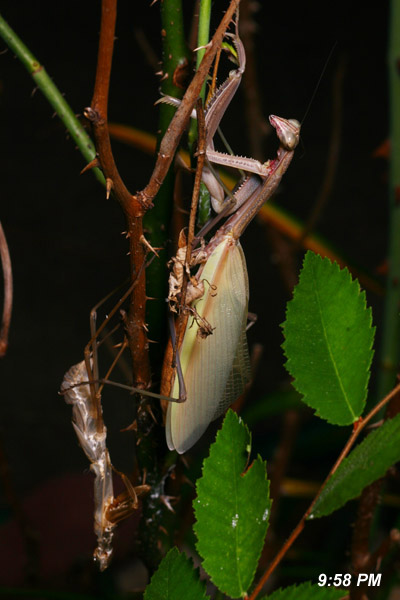 About 48 hours ago as I type this, I was out watering the plants, which have been struggling in the heat and drought conditions. As usual, after the soaking of the roots, I applied a light mist to the leaves, almost entirely for the benefit of the arthropods. You know how it goes: keep the talent happy. Right afterward, I switched on the headlamp (I can water by ambient light) to check out and see what was going on, and found the brown mantis on the rose bush had molted out into an adult not long ago, showing off wings that were still in the process of drying. This, as I’ve said before, has long been a process that I’d like to capture from start to finish, but felt it might be very difficult – not just from knowing when this would take place, but from the idea that, seeing a looming nature photographer nearby, any arthropod might opt to put off the extended vulnerability that molting entails, if this is even within their power. So, seeing this newly-emerged adult, I sighed inwardly and told myself I should have checked on it earlier. Doing my typical rounds, I went over to the Japanese maple to see how the occupant thereof was doing.
About 48 hours ago as I type this, I was out watering the plants, which have been struggling in the heat and drought conditions. As usual, after the soaking of the roots, I applied a light mist to the leaves, almost entirely for the benefit of the arthropods. You know how it goes: keep the talent happy. Right afterward, I switched on the headlamp (I can water by ambient light) to check out and see what was going on, and found the brown mantis on the rose bush had molted out into an adult not long ago, showing off wings that were still in the process of drying. This, as I’ve said before, has long been a process that I’d like to capture from start to finish, but felt it might be very difficult – not just from knowing when this would take place, but from the idea that, seeing a looming nature photographer nearby, any arthropod might opt to put off the extended vulnerability that molting entails, if this is even within their power. So, seeing this newly-emerged adult, I sighed inwardly and told myself I should have checked on it earlier. Doing my typical rounds, I went over to the Japanese maple to see how the occupant thereof was doing.
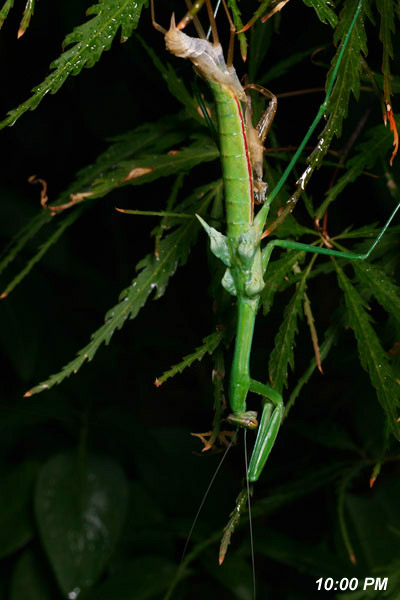 Being greeted by this spectacle, I realized I had caught one still in the process of molting – check out those wing stubs. I had missed most of the details, but could see the wings spread out at least, so I grabbed a bottle of iced Tang and sat down to shoot a sequence of photos. I have provided the times at which the images were shot to give an idea of how long this process, and indeed this session, took. I also want to add that it was still 29°c (84°f) and incredibly humid, so even while sitting largely motionless, I was sweating steadily.
Being greeted by this spectacle, I realized I had caught one still in the process of molting – check out those wing stubs. I had missed most of the details, but could see the wings spread out at least, so I grabbed a bottle of iced Tang and sat down to shoot a sequence of photos. I have provided the times at which the images were shot to give an idea of how long this process, and indeed this session, took. I also want to add that it was still 29°c (84°f) and incredibly humid, so even while sitting largely motionless, I was sweating steadily.
The ideal thing to do in such cases is to shoot regularly-spaced images that can then be sequenced into a time-lapse animation, which is much better than shooting video – this process takes place over such a period of time that it’s only slightly better than watching paint dry. However, the mantis wasn’t inclined to hold one particular position, and I shifted several times, as well as removing a couple of blocking maple leaves, to maintain a decent vantage.
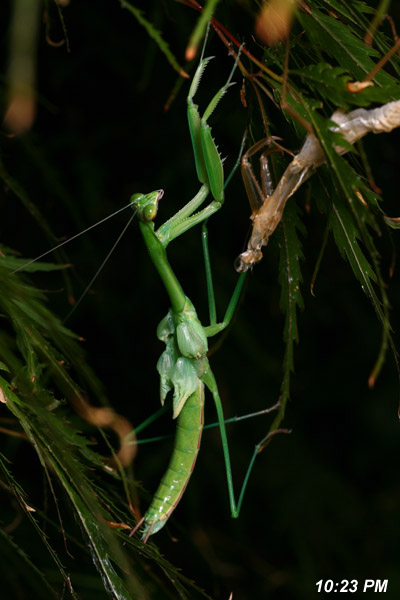 After some minutes and no small amount of twitching and wriggling, the mantis freed itself from the old exoskeleton and turned to face upwards. I have seen a few different arthropods at roughly this stage, and notably they all remained suspended from their abdomen, attached somehow within the exoskeleton anchored to the plant. The feet all have little claws, and these can apparently be locked in place as the feet are withdrawn, but how the abdomen is anchored within I cannot say for certain, though it seems it almost has to be either by genitalia or cloaca. Yeah, I know – sounds real uncomfortable, doesn’t it?
After some minutes and no small amount of twitching and wriggling, the mantis freed itself from the old exoskeleton and turned to face upwards. I have seen a few different arthropods at roughly this stage, and notably they all remained suspended from their abdomen, attached somehow within the exoskeleton anchored to the plant. The feet all have little claws, and these can apparently be locked in place as the feet are withdrawn, but how the abdomen is anchored within I cannot say for certain, though it seems it almost has to be either by genitalia or cloaca. Yeah, I know – sounds real uncomfortable, doesn’t it?
 We’re going to skip a lot of images here (there’s a reason) and show the almost completely-extended wings – note the time difference. No movement is actually seen from the wings at all, though the mantis does the occasional leg and abdominal flex while this is taking place, and is free to shift position. I knew that the only thing to see from this point on would be the settling of the wings into position and their slow change into the normal adult coloration – checking on the brown mantis that I had first seen, I knew this might take an hour or more to occur, with few images to shoot during that time, so I elected to wrap it up here.
We’re going to skip a lot of images here (there’s a reason) and show the almost completely-extended wings – note the time difference. No movement is actually seen from the wings at all, though the mantis does the occasional leg and abdominal flex while this is taking place, and is free to shift position. I knew that the only thing to see from this point on would be the settling of the wings into position and their slow change into the normal adult coloration – checking on the brown mantis that I had first seen, I knew this might take an hour or more to occur, with few images to shoot during that time, so I elected to wrap it up here.
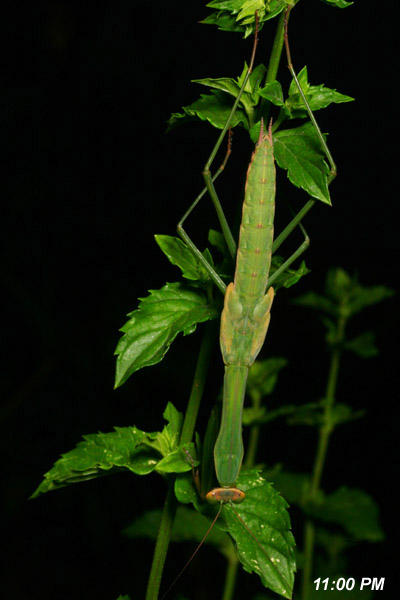 The same mantis seen at top was still perched on the spearmint plant, but I took note of something: the eyes were not black, as they typically are at night, and the only times I’ve seen mantids without dark eyes this late at night has been when they’re very young, or as seen with the others in this post, when they’re molting. I remarked in a previous post that I’m not sure why this is, but it seems to be under some control. I watched this one for a short while, taking a close image of the back where the chitin will begin to split as the molting starts, then went inside and unloaded the memory card. I figured, if I left the mantis alone until it felt safe enough to begin, I could then capture the sequence after it was committed. Close examination of the image showed no hint of spreading or stretching of the chitin that would indicate the process had started already.
The same mantis seen at top was still perched on the spearmint plant, but I took note of something: the eyes were not black, as they typically are at night, and the only times I’ve seen mantids without dark eyes this late at night has been when they’re very young, or as seen with the others in this post, when they’re molting. I remarked in a previous post that I’m not sure why this is, but it seems to be under some control. I watched this one for a short while, taking a close image of the back where the chitin will begin to split as the molting starts, then went inside and unloaded the memory card. I figured, if I left the mantis alone until it felt safe enough to begin, I could then capture the sequence after it was committed. Close examination of the image showed no hint of spreading or stretching of the chitin that would indicate the process had started already.
I came out and checked about 20 minutes later, to find no change in condition (though a possible change of position from the mantis,) and went back inside for a while. Then I got involved in a project and spent more time than intended before I came back out to check again. Ominous music here.
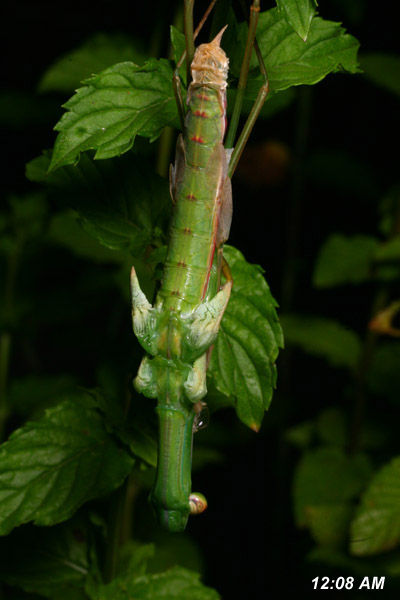 You knew it was going to happen, didn’t you? But I defend my reasoning in not making the mantis feel threatened before it began, and can only admit to taking longer than I should’ve between checks – with no real idea how long the full process lasted. But yeah, stupid me.
You knew it was going to happen, didn’t you? But I defend my reasoning in not making the mantis feel threatened before it began, and can only admit to taking longer than I should’ve between checks – with no real idea how long the full process lasted. But yeah, stupid me.
Now, if you’re wondering, no, there is no ‘coordination’ I know of where mantids molt into adults on the same night, and the latter two were both notably smaller than the brown one, who I would have thought would have reached adulthood before the rose bush mantis. Moreover, the pattern I seemed to see from earlier molts has been that it often takes place after a rain, and we were as far as possible from rain that night. So, is three of them all molting within hours of one another just a coincidence, or provoked by something? I can’t tell you (because you don’t need to know.) If someone does know, however, please fill me in – forewarned would be so much better.
Before we move on, compare the wings before and after – we’re going to be getting a closer look at them.
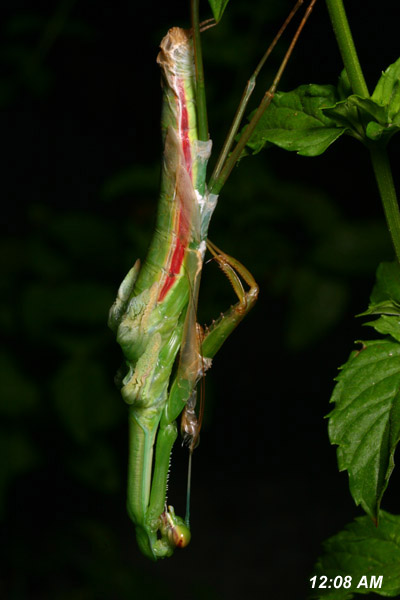 Seen from the side, we now know why the head was tucked so tightly to its chest, since the antennae still aren’t free. In fact, the forelimbs are still working their way out, only clear to the elbow, while the hind limbs are barely started – the blob right at the first joint is the head portion of the exoskeleton. We’re going to keep watching without comments from the Peanut Gallery (briefly – c’mon, do you really expect me to shut up for any length of time?) as the process continues. Again, check the times.
Seen from the side, we now know why the head was tucked so tightly to its chest, since the antennae still aren’t free. In fact, the forelimbs are still working their way out, only clear to the elbow, while the hind limbs are barely started – the blob right at the first joint is the head portion of the exoskeleton. We’re going to keep watching without comments from the Peanut Gallery (briefly – c’mon, do you really expect me to shut up for any length of time?) as the process continues. Again, check the times.

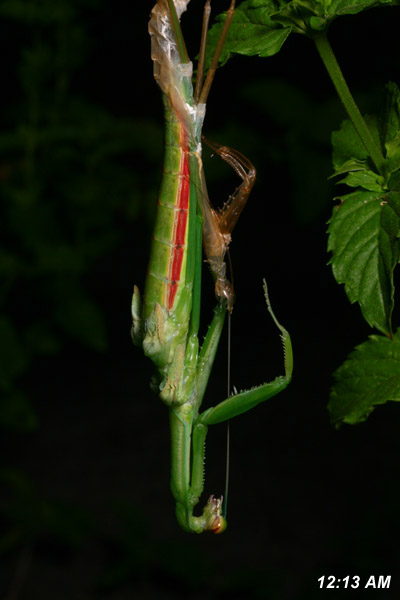

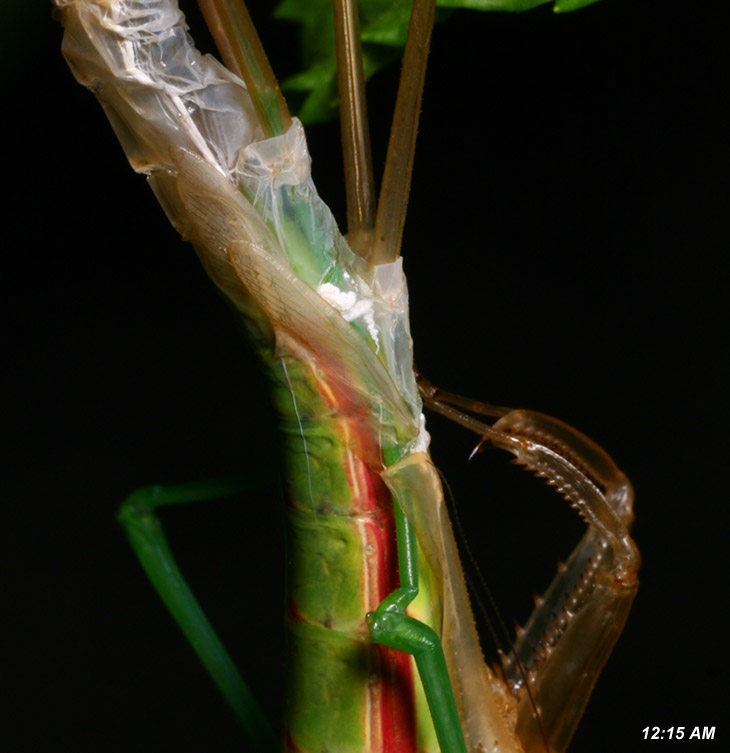
This is where it got really interesting, and I had to show a cropped detail shot. No, mantids do not have that many joints in their limbs – this is showing the softness and flexibility of the new chitin as the mantis struggled to free the hind leg from the old exoskeleton. You can see from the color within that now the middle limbs are pretty much shed (upper right,) but the hind limbs are still visible within the old chitin, between the middle limb skins and the abdomen. You can just barely make out the split seam of the old exoskeleton, with the wing sheaths plainly visible, and something more. As I found out last year, arthropods shed not only their external covering, but the linings of their ‘lungs,’ or more specifically, the tracheoles along the lateral margins of their abdomens that feed air almost directly into the tissues through a branching network, akin to a circulatory system. Thus, the little white squiggle you see right alongside the wings is likely the old tracheoles, with more of them visible towards the top of the frame.
 In fact, let’s take a close look at those. The little pale puckers you see to the left of the red line are the spiracles – all the oxygen that the mantis needs comes through them. Yeah, arthropods use air much more efficiently than mammals do. As for the ragged, tattered appearance of the abdomen along the red line? Got me – sure doesn’t look watertight, does it? My best guess is that this closes up as the chitin hardens and the flexing necessary for molting has ceased.
In fact, let’s take a close look at those. The little pale puckers you see to the left of the red line are the spiracles – all the oxygen that the mantis needs comes through them. Yeah, arthropods use air much more efficiently than mammals do. As for the ragged, tattered appearance of the abdomen along the red line? Got me – sure doesn’t look watertight, does it? My best guess is that this closes up as the chitin hardens and the flexing necessary for molting has ceased.
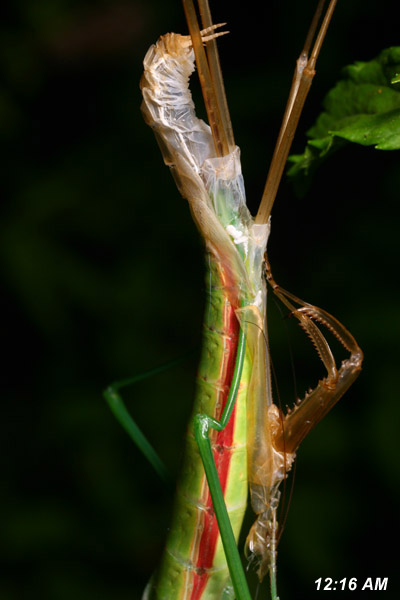 The hind limbs seemed to take a while to get free, and I cannot tell you if this was normal or not, but I’ve had almost as much trouble trying to get out of a wet long-sleeved sweater, and performed much the same maneuvers. Albeit with less creepy limb bending.
The hind limbs seemed to take a while to get free, and I cannot tell you if this was normal or not, but I’ve had almost as much trouble trying to get out of a wet long-sleeved sweater, and performed much the same maneuvers. Albeit with less creepy limb bending.
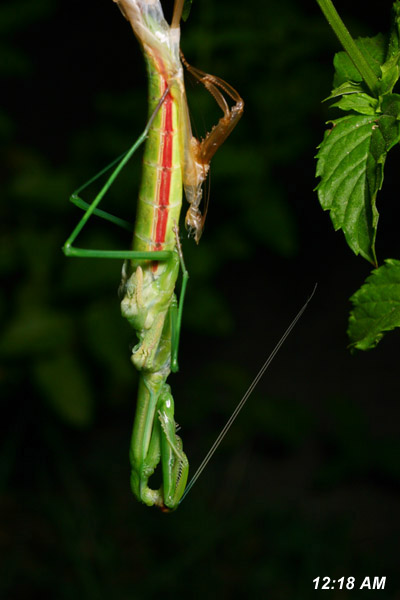 Ah, there we go! And exactly as you’d expect, the mantis spent a bit of time stretching out the newly-freed limbs, though much slower than you might imagine. This is roughly the point where I happened along on the earlier mantis that evening (well, okay, the previous evening now, if you want to get technical,) so I suspected there would be a delay, probably from waiting for the limbs to harden enough to function dependably and support the mantis’ weight. So while we wait, we’ll go in for another closeup. Isn’t macro work fun?
Ah, there we go! And exactly as you’d expect, the mantis spent a bit of time stretching out the newly-freed limbs, though much slower than you might imagine. This is roughly the point where I happened along on the earlier mantis that evening (well, okay, the previous evening now, if you want to get technical,) so I suspected there would be a delay, probably from waiting for the limbs to harden enough to function dependably and support the mantis’ weight. So while we wait, we’ll go in for another closeup. Isn’t macro work fun?

We really needed a close look at the wings, and it was informative to me at least. I kind of expected them to be folded or rolled – I mean, even flowers form rather geometrically – but the wings looked like they’d been jammed into the sub-adult exoskeleton like a sock that’s worked off and sits in the toe of your boot. Very brainlike appearance. Also note, while we’re here, the translucence of the still-soft exoskeleton and the faint details visible within. Is this cool or what?
Though the night wasn’t over yet…
[Okay, it was, but that sounds better than, “The morning wasn’t over yet” – let me have my poetry.]
While just waiting for the mantis to start freeing itself from the exoskeleton completely, I glanced over at the other spearmint plant right alongside. Seriously, what the hell was going on that night?
 Less than a meter away, a cicada of unknown species was molting out as well. In fact, it was close enough that, with some angles, I had to be careful not to bump the mantis with my head while lying on my side to get photos of the cicada.
Less than a meter away, a cicada of unknown species was molting out as well. In fact, it was close enough that, with some angles, I had to be careful not to bump the mantis with my head while lying on my side to get photos of the cicada.
I want to take a moment to paint this picture for you. The spearmint plants are less than a meter in height, and both the mantis and the cicada were at the same distance off the ground, 30 cm or so. Depth of field with macro work is very short, so it works best if you get the length of the subject’s body nice and flat to the camera, so all of it gets into a range of sharp focus – compare the first, daylight image at top to see the effect, though hugely magnified in that image since it was shot at f4, rather than f16 like nearly all of the rest in this post. Depending on the angle that the insect was at, I needed to be flat on the ground on my side, often aiming slightly upwards, and for many of these pics I had to hold my head about 10 cm off the ground. It doesn’t take long before this really starts pulling on the neck. Thus, between shots I was often lying flat on my back on the grass to loosen the neck muscles, and thankfully no one was walking past on the road to wonder what I was doing lying there with a bulky camera rig after midnight, staring up at the sky…
 Those curled wings were simply fascinating, like overcooked bacon, and the flash was really bringing out the curious coloration of the translucent chitin. A few days previously I had inadvertently stepped on a cicada, newly emerged from the ground and ready to attach to a tree and molt into an adult. I felt doubly bad, since I try not to step on any insects if I can avoid it, but also since this was exactly what I’d been watching for: an arthropod immediately before molting. And in fact, that accident had occurred not two meters from this spot. That one, however, had been about half the size of the one pictured here, which is the largest cicada I think I’ve seen.
Those curled wings were simply fascinating, like overcooked bacon, and the flash was really bringing out the curious coloration of the translucent chitin. A few days previously I had inadvertently stepped on a cicada, newly emerged from the ground and ready to attach to a tree and molt into an adult. I felt doubly bad, since I try not to step on any insects if I can avoid it, but also since this was exactly what I’d been watching for: an arthropod immediately before molting. And in fact, that accident had occurred not two meters from this spot. That one, however, had been about half the size of the one pictured here, which is the largest cicada I think I’ve seen.
 Keeping an eye on the mantis, I started working with the fourth molt that I’d found that night, at about an equal point in the process. Makes me wish I’d been looking around more, earlier, and caught this from the beginning. These were, more or less, in range of the porch light, which I’d turned on as soon as I’d started watching the mantis on the spearmint, but easy enough to lose in the shadows as well, so most of the detail I could see was shown by either my headlamp or the focusing lamp on the flash unit. In fact, I went through a significant number of batteries that evening, between the headlamp and dozens of flash discharges, but that’s why I have stacks of rechargeables.
Keeping an eye on the mantis, I started working with the fourth molt that I’d found that night, at about an equal point in the process. Makes me wish I’d been looking around more, earlier, and caught this from the beginning. These were, more or less, in range of the porch light, which I’d turned on as soon as I’d started watching the mantis on the spearmint, but easy enough to lose in the shadows as well, so most of the detail I could see was shown by either my headlamp or the focusing lamp on the flash unit. In fact, I went through a significant number of batteries that evening, between the headlamp and dozens of flash discharges, but that’s why I have stacks of rechargeables.
 In time, the cicada started stretching out its legs, and I was pretty certain this was preparatory to snagging a perch and freeing itself from the old chitin so, ensuring that the mantis wasn’t doing anything yet, I stayed with the cicada and watched carefully. But let’s take a closer look at that belly while we’re here.
In time, the cicada started stretching out its legs, and I was pretty certain this was preparatory to snagging a perch and freeing itself from the old chitin so, ensuring that the mantis wasn’t doing anything yet, I stayed with the cicada and watched carefully. But let’s take a closer look at that belly while we’re here.

Isn’t that a lovely palette? Very tastefully done, though The Girlfriend suggested that this was where some of the creatures from the Men In Black movies originated. And she might be right.
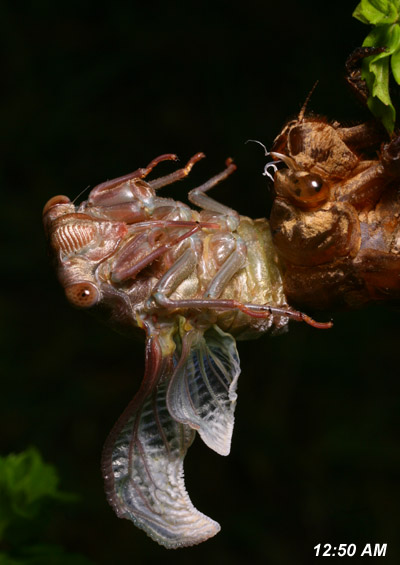 As expected, the cicada soon bent over and grabbed its own exoskeleton, pulling itself free from it with considerably less effort than the mantises seemed to need. And abruptly, almost escaping my attention, those wings had started to unfurl.
As expected, the cicada soon bent over and grabbed its own exoskeleton, pulling itself free from it with considerably less effort than the mantises seemed to need. And abruptly, almost escaping my attention, those wings had started to unfurl.
 Watch those times, since you’ll get to compare them against the mantis; the wings popped out remarkably fast.
Watch those times, since you’ll get to compare them against the mantis; the wings popped out remarkably fast.
 You might expect to see some pulsing of the wings as fluid pumped into them, or flexing or something, but arthropod circulation is not like ours, and the wings simply grew like leaves, not visibly moving but always further along when you looked back after turning away. The abdomen would twitch from time to time, but that was about it for deliberate movement.
You might expect to see some pulsing of the wings as fluid pumped into them, or flexing or something, but arthropod circulation is not like ours, and the wings simply grew like leaves, not visibly moving but always further along when you looked back after turning away. The abdomen would twitch from time to time, but that was about it for deliberate movement.
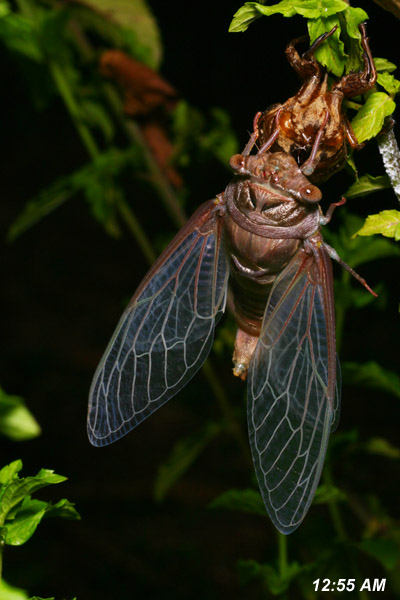 You might also expect the wings to, at some point,stretch out to the side, maybe do a few slow test flaps or something, but neither the mantids nor the cicada did anything of the sort, probably because the wings needed to harden thoroughly before anything like that was attempted. I have seen insects with malformed wings, possibly due to some disturbance or damage immediately following molt, but I presume genetic defects are also a possibility.
You might also expect the wings to, at some point,stretch out to the side, maybe do a few slow test flaps or something, but neither the mantids nor the cicada did anything of the sort, probably because the wings needed to harden thoroughly before anything like that was attempted. I have seen insects with malformed wings, possibly due to some disturbance or damage immediately following molt, but I presume genetic defects are also a possibility.
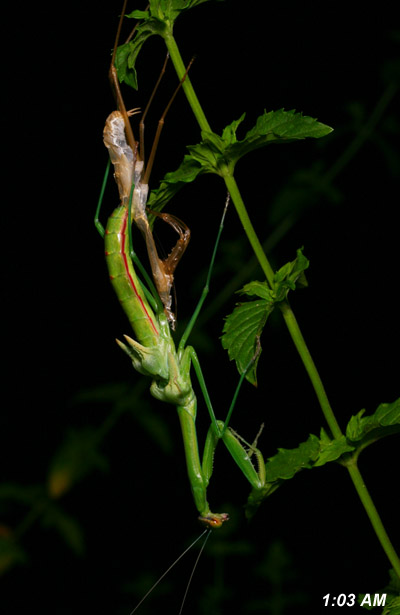 The mantis could be seen extending its legs and perching onto the spearmint plant, so I switched back to that position – credit to them both for alternating their activities so, now that I was finally on the ball, I wasn’t missing anything.
The mantis could be seen extending its legs and perching onto the spearmint plant, so I switched back to that position – credit to them both for alternating their activities so, now that I was finally on the ball, I wasn’t missing anything.
I am assuming this specimen was a male, since it was performing agitated wriggles and shifts almost identical to myself when the shorts have been holding in too much of the day’s heat. With a wrench of obvious effort, the mantis removed itself from the embrace of its old skin and immediately turned around to face upwards, letting the wings hang down; I am guessing this assists in their expansion.
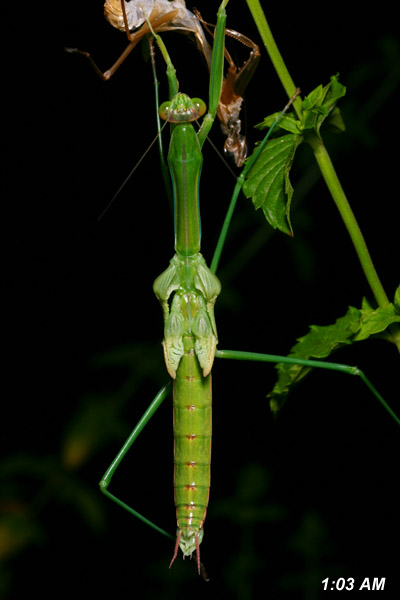 The thin stalks and sporadic leaves of the spearmint plant, while a delightful smell to be working alongside for this extended session, were not the ideal perch for the mantis, who often probed the air in an anxious-looking manner trying for a foothold.
The thin stalks and sporadic leaves of the spearmint plant, while a delightful smell to be working alongside for this extended session, were not the ideal perch for the mantis, who often probed the air in an anxious-looking manner trying for a foothold.
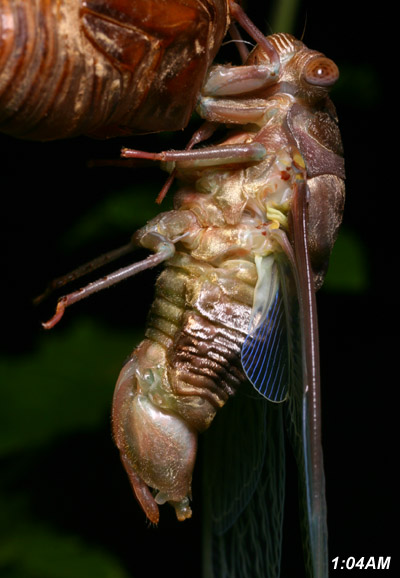 I was still keeping an eye on the cicada, and this flash angle brought out some great colors from the wings and abdomen.
I was still keeping an eye on the cicada, and this flash angle brought out some great colors from the wings and abdomen.
 Pay attention to those wings, as well as the times…
Pay attention to those wings, as well as the times…
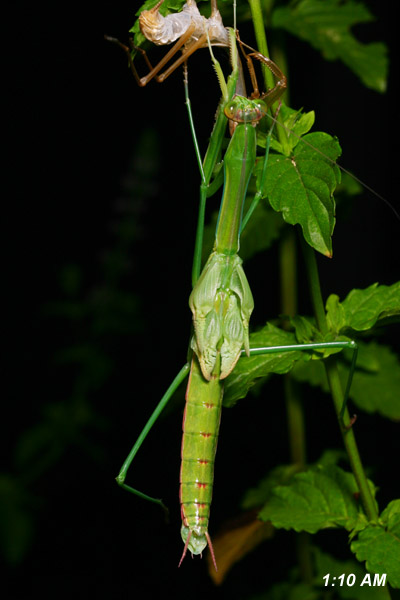 [This post is taking as much time to write as it did to shoot, and the images were already edited before I started this…]
[This post is taking as much time to write as it did to shoot, and the images were already edited before I started this…]
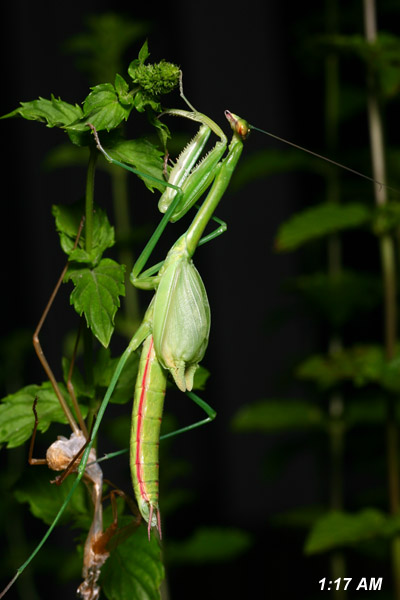 As this took place, the mantis started doing some ‘pullup’ motions, perhaps intent on finding a better perch, perhaps only provoking the circulation to help the wings extend. Its weight was bending over the mint stalk, so it would have needed to switch to another if it wanted a sturdier support. Should have thought of that before it commenced…
As this took place, the mantis started doing some ‘pullup’ motions, perhaps intent on finding a better perch, perhaps only provoking the circulation to help the wings extend. Its weight was bending over the mint stalk, so it would have needed to switch to another if it wanted a sturdier support. Should have thought of that before it commenced…
 Dum de dum de dum dum…
Dum de dum de dum dum…
 This is better than a half hour after freeing itself from the exoskeleton, and ninety minutes since I found it already well along in the molting process – obviously this is a time-consuming thing. Two and a half hours earlier, I’d looked at this one and speculated about whether it was going to molt. Nature photography is not for those with short attention spans (or a nervous bladder.)
This is better than a half hour after freeing itself from the exoskeleton, and ninety minutes since I found it already well along in the molting process – obviously this is a time-consuming thing. Two and a half hours earlier, I’d looked at this one and speculated about whether it was going to molt. Nature photography is not for those with short attention spans (or a nervous bladder.)
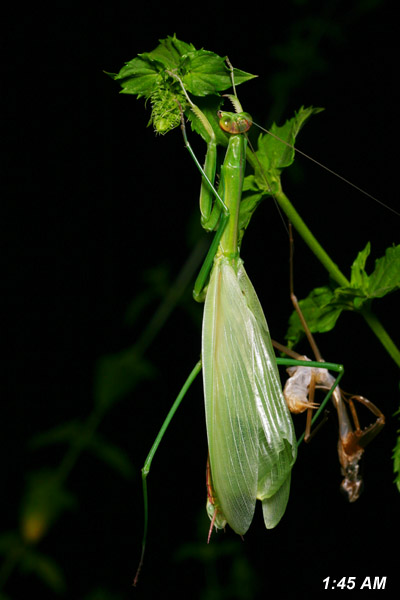 The wings are almost at full extension here, and at this point I took a quick look around just to see if anything else was about to start molting, even though I was tired enough that I might not have followed through if I found something. I was sweaty and hot, itchy from lying on the grass, and had a seriously stiff neck – but a pile of images that I’d never gotten before. I don’t think I got a bad deal.
The wings are almost at full extension here, and at this point I took a quick look around just to see if anything else was about to start molting, even though I was tired enough that I might not have followed through if I found something. I was sweaty and hot, itchy from lying on the grass, and had a seriously stiff neck – but a pile of images that I’d never gotten before. I don’t think I got a bad deal.
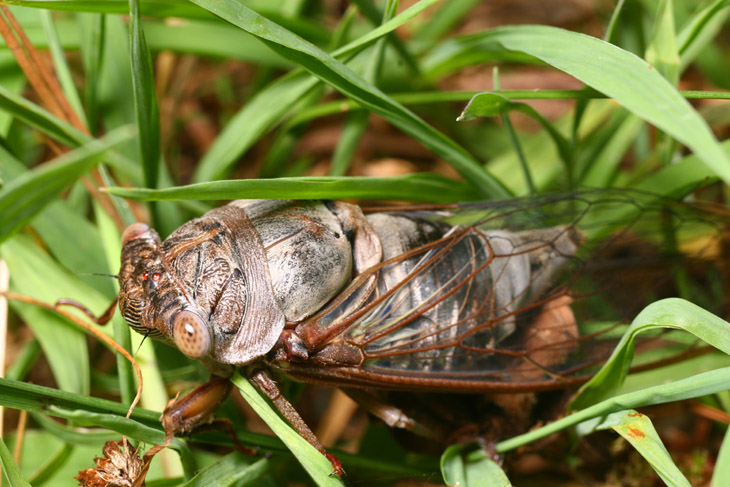
The next morning (from my personal “day” definition,) the mantis was still largely in position, but the cicada appeared to have moved on… until I found it in the grass practically underneath the mantis (suspicious, that.) I have never seen one with this coloration, and so far have not been able to turn up the species. I let it be after this photo and it was gone the next time I checked – just my luck it’ll be something rare that entomologists would pay thousands of dollars to obtain (that happens, right?) But as the rains finally arrived yesterday evening, the mantis sought shelter and was soon found perched on the edge of our front door, so I was able to go out and do not just an adult shot, with the wings now showing their typical coloration, but a scale shot as well. The mantis wasn’t exactly thrilled about this, but not too panicky either.

So the next phase is mating (actually, that doesn’t sound right following an image of a mantis on my hand, so let me assure you that I am not involved in this process.) I have to wonder if I’ll get the chance to capture images of that, too – I haven’t managed it yet. Keep checking back.
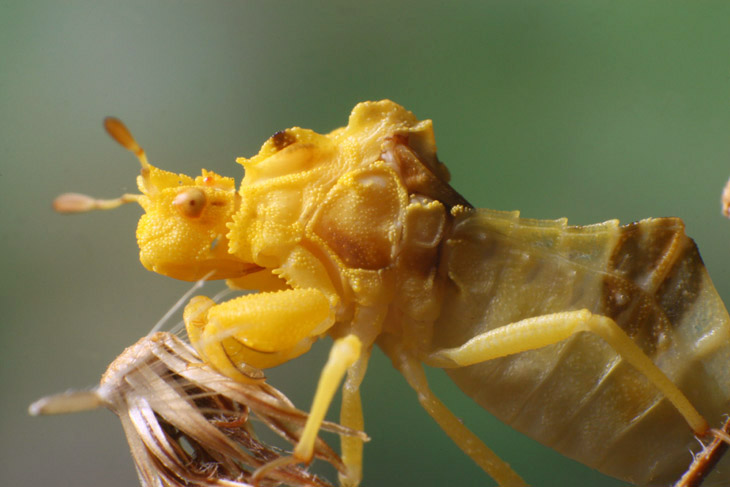
 Ambush bugs are predatory ‘true bugs,’ or Hemipterans, and usually find themselves a perch on a likely flower and await the appearance of pollinators. To say that they are sedentary is perhaps understating it; I have never seen one actually going anyplace, and even when provoked they are reluctant to give up their position. Both of these (if you can’t tell them apart that’s okay, neither can I) possessed wings and yet never made any attempt to fly away. This leads me to speculate that they rely almost entirely on their camouflage and caruncular exoskeleton for defense; usually they blend in much better than this, but we had no yellow flowers around to use as a setting. Also, since a lot of species count on movement rather than appearance in spotting prey, the tendency towards immobility that these bugs appear to possess might be sufficient all by itself. We’ll see more about that shortly. Right now, we’ll go in for a little closer look at the business end of things.
Ambush bugs are predatory ‘true bugs,’ or Hemipterans, and usually find themselves a perch on a likely flower and await the appearance of pollinators. To say that they are sedentary is perhaps understating it; I have never seen one actually going anyplace, and even when provoked they are reluctant to give up their position. Both of these (if you can’t tell them apart that’s okay, neither can I) possessed wings and yet never made any attempt to fly away. This leads me to speculate that they rely almost entirely on their camouflage and caruncular exoskeleton for defense; usually they blend in much better than this, but we had no yellow flowers around to use as a setting. Also, since a lot of species count on movement rather than appearance in spotting prey, the tendency towards immobility that these bugs appear to possess might be sufficient all by itself. We’ll see more about that shortly. Right now, we’ll go in for a little closer look at the business end of things.
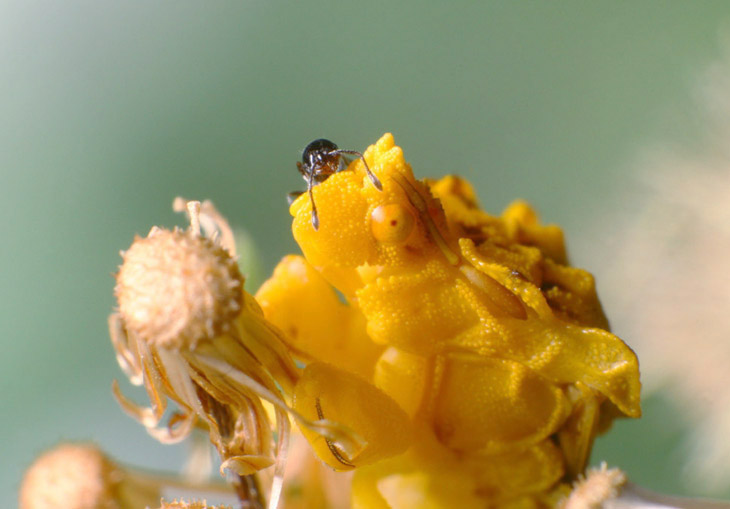
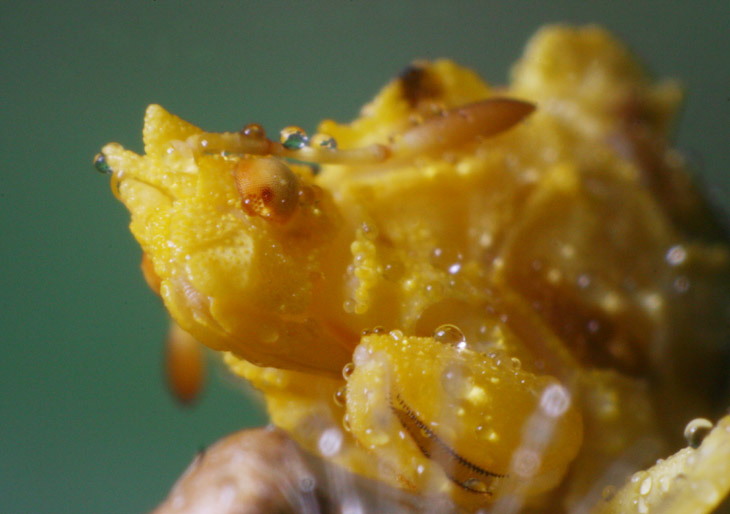
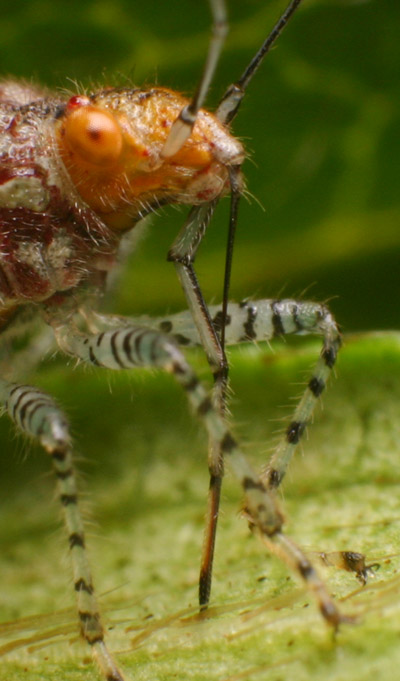 If you look closely at the base of the proboscis in the image above, right at the point of the ‘nose,’ you can see a little gap with a paler, ridged something in there. The proboscis is actually a multi-part appendage, as I discovered by accident in some previous macro pics, prompting me to seek more like the one at left. There is a hard outer ‘cutting/stabbing’ sheath, often articulated, called the labium. Fitting within it are the bits that do the actual drinking, looking like a fine thread even though there are actually four parts, collectively called the stylets, separately a pair each of mandibles and maxillae, terms you might recognize from just about any anatomy lesson, otherwise known as the lower and upper jaws respectively. The separate nature of the labium and stylets is nicely shown with this scentless plant bug (Niesthrea louisianica) that obligingly posed for me while feeding from a leaf. Diagrams and explanations of all this can be found here.
If you look closely at the base of the proboscis in the image above, right at the point of the ‘nose,’ you can see a little gap with a paler, ridged something in there. The proboscis is actually a multi-part appendage, as I discovered by accident in some previous macro pics, prompting me to seek more like the one at left. There is a hard outer ‘cutting/stabbing’ sheath, often articulated, called the labium. Fitting within it are the bits that do the actual drinking, looking like a fine thread even though there are actually four parts, collectively called the stylets, separately a pair each of mandibles and maxillae, terms you might recognize from just about any anatomy lesson, otherwise known as the lower and upper jaws respectively. The separate nature of the labium and stylets is nicely shown with this scentless plant bug (Niesthrea louisianica) that obligingly posed for me while feeding from a leaf. Diagrams and explanations of all this can be found here. After the photo session, I took both ambush bug specimens out and tried to find appropriate places for them. One went onto the flowers of the spearmint plants, and the other onto a geranium bloom – like I said, we don’t have any yellow flowers around here. The geranium was apparently unacceptable, since I haven’t seen it there since, but the one on the mint seemed to be okay with the choice, considering that it is still there as I type this, a week since its release – that’s it in the pic, obviously not camouflaged terribly well, yet still in flattering colors (if I’m any judge, which I’m probably not.) Faintly visible in this image is the red spot on the back of the ‘skull,’ also visible in one of the photos above and the one with the scentless plant bug. These are small simple eyes called ocelli, primarily believed to help flying insects maintain stable flight. If you roll back a few posts, you can see them on the mantises and the cicada as well.
After the photo session, I took both ambush bug specimens out and tried to find appropriate places for them. One went onto the flowers of the spearmint plants, and the other onto a geranium bloom – like I said, we don’t have any yellow flowers around here. The geranium was apparently unacceptable, since I haven’t seen it there since, but the one on the mint seemed to be okay with the choice, considering that it is still there as I type this, a week since its release – that’s it in the pic, obviously not camouflaged terribly well, yet still in flattering colors (if I’m any judge, which I’m probably not.) Faintly visible in this image is the red spot on the back of the ‘skull,’ also visible in one of the photos above and the one with the scentless plant bug. These are small simple eyes called ocelli, primarily believed to help flying insects maintain stable flight. If you roll back a few posts, you can see them on the mantises and the cicada as well.























































 Our attempts to catch up continue, as we hearken back to six days ago and a visit to a nearby pond. A variation of this view was seen
Our attempts to catch up continue, as we hearken back to six days ago and a visit to a nearby pond. A variation of this view was seen  The light was just barely bright enough to shine through the broad leaves, and this suspicious little oval shadow is something that I’ve seen before. Only about the size of the top joint of your thumb, it was the right size and the right shape for a typical position of a treefrog, since they often sit with their legs tucked tightly in, much like cats. This was deep in a thick patch of the water plants, however, and while I could manage a decent view from this side, the other side was going to prove difficult.
The light was just barely bright enough to shine through the broad leaves, and this suspicious little oval shadow is something that I’ve seen before. Only about the size of the top joint of your thumb, it was the right size and the right shape for a typical position of a treefrog, since they often sit with their legs tucked tightly in, much like cats. This was deep in a thick patch of the water plants, however, and while I could manage a decent view from this side, the other side was going to prove difficult.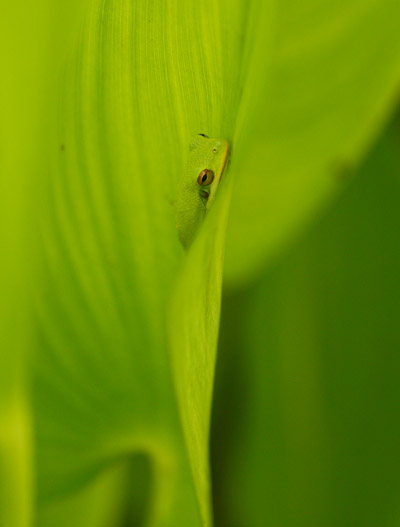 In time, I managed to get to a position that was just barely adequate, seeing through a gap in the surrounding plants right along the edge of the leaf, but enough to reveal that the source of the shadow was exactly as suspected. I told you the color was a close match. This green treefrog (Hyla cinerea) was about half of adult size, being less than 3 cm in body length. I wanted to work with the lower contrast and specific colors of natural light, so I left the flash in the bag, but the overcast conditions meant I was once again shooting mostly at largest aperture (f4 in this case, the wonderful Mamiya 80mm macro that fits on my Canon cameras with a custom mount.) This had the effect that, with the short focus, the frog almost seems to blur into the leaf itself. I might have to do some more experiments with short depth-of-field in these situations…
In time, I managed to get to a position that was just barely adequate, seeing through a gap in the surrounding plants right along the edge of the leaf, but enough to reveal that the source of the shadow was exactly as suspected. I told you the color was a close match. This green treefrog (Hyla cinerea) was about half of adult size, being less than 3 cm in body length. I wanted to work with the lower contrast and specific colors of natural light, so I left the flash in the bag, but the overcast conditions meant I was once again shooting mostly at largest aperture (f4 in this case, the wonderful Mamiya 80mm macro that fits on my Canon cameras with a custom mount.) This had the effect that, with the short focus, the frog almost seems to blur into the leaf itself. I might have to do some more experiments with short depth-of-field in these situations…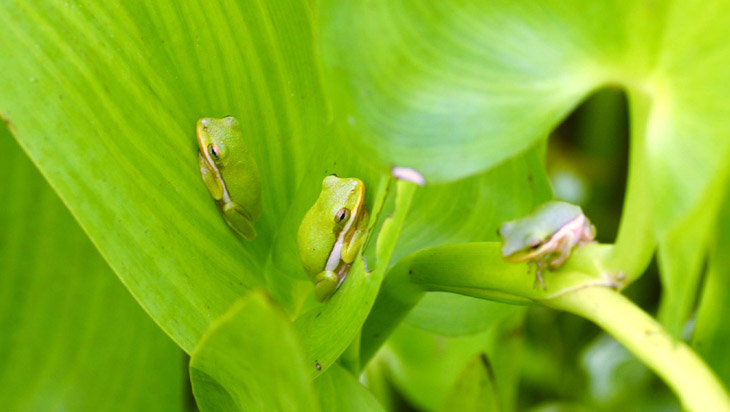
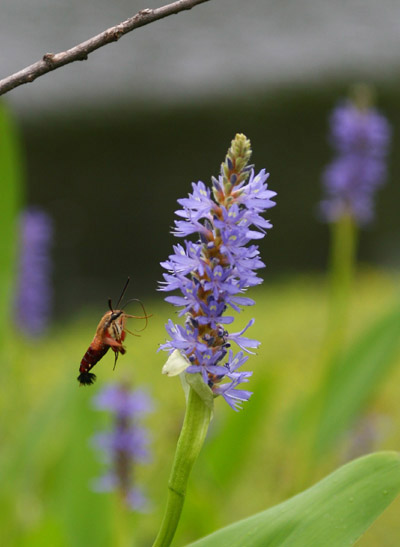 While all of this was going on, I was often in the middle of bumblebees feeding from the flowers, and what I suspect was a solitary clearwing moth, seen several times over. I did not get a close enough image to pin down the exact species (the color of the legs is the key trait,) but I think it was Hemaris thysbe – certainly genus Hemaris, anyway. They’re fun insects to watch, but hyperactive enough to make good photos challenging, not helped at all by the fact that they never land when feeding, instead hovering at the flowers like the hummingbirds that they often mimic. They also mimic bumblebees, and this trait is enough to distinguish them easily because bumblebees always land on the flowers.
While all of this was going on, I was often in the middle of bumblebees feeding from the flowers, and what I suspect was a solitary clearwing moth, seen several times over. I did not get a close enough image to pin down the exact species (the color of the legs is the key trait,) but I think it was Hemaris thysbe – certainly genus Hemaris, anyway. They’re fun insects to watch, but hyperactive enough to make good photos challenging, not helped at all by the fact that they never land when feeding, instead hovering at the flowers like the hummingbirds that they often mimic. They also mimic bumblebees, and this trait is enough to distinguish them easily because bumblebees always land on the flowers. And finally, the last frog captured that morning, in a session that lasted all of fifteen minutes – I just stopped briefly to check on things while running other errands. Yes, this was the last stop before returning home with my filthy feet – I have a little decorum left, and won’t go to public places looking like some derelict. Or even more so than necessary, anyway.
And finally, the last frog captured that morning, in a session that lasted all of fifteen minutes – I just stopped briefly to check on things while running other errands. Yes, this was the last stop before returning home with my filthy feet – I have a little decorum left, and won’t go to public places looking like some derelict. Or even more so than necessary, anyway.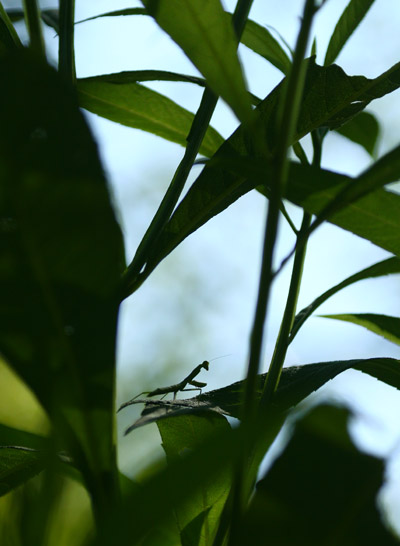 In the past week, I shot about 600 images in four sessions or so, which partially explains the lack of posts. So we’ll play catch-up over a couple of days, and in the process see the difference in approach used, depending on the subject and circumstances.
In the past week, I shot about 600 images in four sessions or so, which partially explains the lack of posts. So we’ll play catch-up over a couple of days, and in the process see the difference in approach used, depending on the subject and circumstances.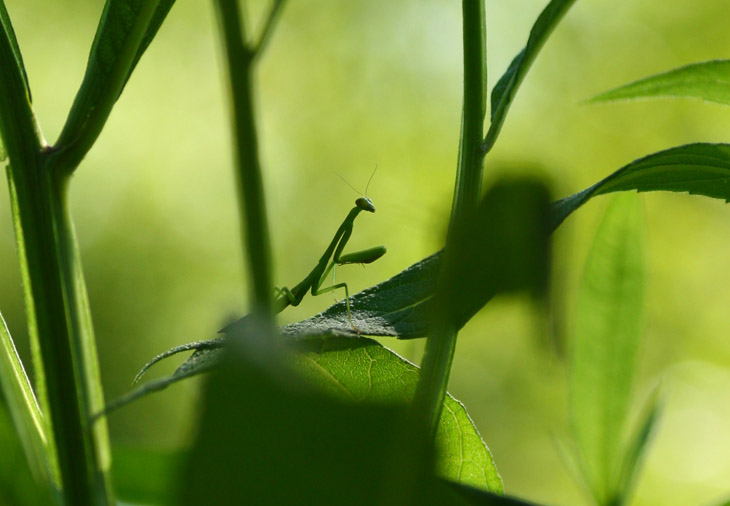
 I have a few images of this eentsy treefrog that show the face better, but this one gives a dramatic impression of scale with the entire leaf visible. This is likely a squirrel treefrog (Hyla squirella,) and probably the same species captured
I have a few images of this eentsy treefrog that show the face better, but this one gives a dramatic impression of scale with the entire leaf visible. This is likely a squirrel treefrog (Hyla squirella,) and probably the same species captured 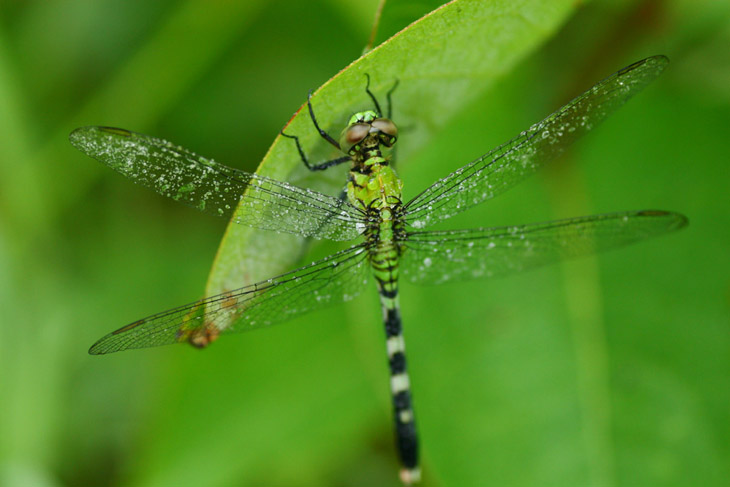
 This dragonfly, an eastern pondhawk (Erythemis simplicicollis,) was the first species captured that day, before the sun had risen enough to break through most of the trees and evaporate off the dew – while I admit to plying a misting bottle in situations where it can add to the image, the moisture here is natural, and fairly common with dragonflies in the right conditions. And since dragonflies need a good level of warmth in their wing muscles along the thorax to fly (the reason why they’re always found perching on reeds in bright sunlight,) any this covered in dew are unlikely to fly away at a close approach. However, with a very slow approach, you can actually get them to perch on a fingertip at any time, because they view speed as a threat and glacial movements simply don’t register in this way. Go straight in towards the head, and gently push up against the face or forelegs when you make contact – no, they don’t bite.
This dragonfly, an eastern pondhawk (Erythemis simplicicollis,) was the first species captured that day, before the sun had risen enough to break through most of the trees and evaporate off the dew – while I admit to plying a misting bottle in situations where it can add to the image, the moisture here is natural, and fairly common with dragonflies in the right conditions. And since dragonflies need a good level of warmth in their wing muscles along the thorax to fly (the reason why they’re always found perching on reeds in bright sunlight,) any this covered in dew are unlikely to fly away at a close approach. However, with a very slow approach, you can actually get them to perch on a fingertip at any time, because they view speed as a threat and glacial movements simply don’t register in this way. Go straight in towards the head, and gently push up against the face or forelegs when you make contact – no, they don’t bite.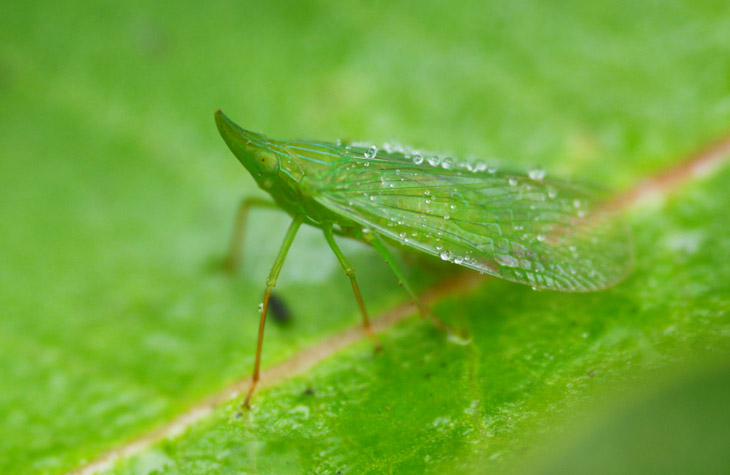
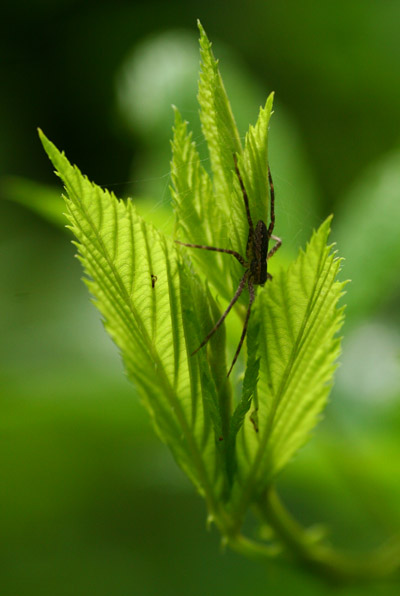 The dew had already boiled off by the time we found several nursery web spiders (Pisaurina mira,) all perched in similar positions atop their own stalks of raspberry plants. To me, there’s something evocative of the early morning sunlight shining through yet the spider appears to be shunning it. While this is likely true, because it will help them avoid birds, I cannot say this definitively, especially since we only had the one angle to work from, so couldn’t test the theory by finding any others on the sunny side of the plants.
The dew had already boiled off by the time we found several nursery web spiders (Pisaurina mira,) all perched in similar positions atop their own stalks of raspberry plants. To me, there’s something evocative of the early morning sunlight shining through yet the spider appears to be shunning it. While this is likely true, because it will help them avoid birds, I cannot say this definitively, especially since we only had the one angle to work from, so couldn’t test the theory by finding any others on the sunny side of the plants.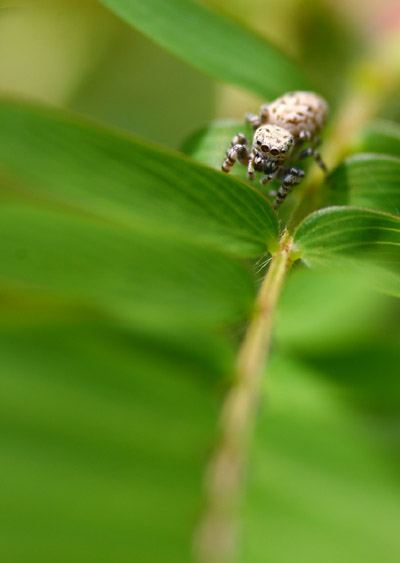 We close with another spider, this one a jumping spider, likely
We close with another spider, this one a jumping spider, likely  I’m sorry, I’m sorry, I’m sorry! I lost track of what day it was and was concentrating on other things, but that’s just pathetic whining under the looming threat of the whip. To try and make up for it, however (now that your day is already off to a bad start,) I humbly offer this remarkably current image, taken less than an hour ago. It’s almost like a Twatter account (or Instagrump or Pisinterest or whatever the hell applies,) but without the soul-destroying lameness.
I’m sorry, I’m sorry, I’m sorry! I lost track of what day it was and was concentrating on other things, but that’s just pathetic whining under the looming threat of the whip. To try and make up for it, however (now that your day is already off to a bad start,) I humbly offer this remarkably current image, taken less than an hour ago. It’s almost like a Twatter account (or Instagrump or Pisinterest or whatever the hell applies,) but without the soul-destroying lameness. This is going to be the longest post on the blog. Not in terms of words, but in terms of images, since I am going to show a long sequence from the other evening, and they’re nearly all vertical format, so the linear dimensions of the post are going to be exceptional. This may result in some gaps between text blocks, so please excuse the formatting. Plus, this will easily be the most images for a single post, and by itself will exceed the uploads for many previous months. And, this is about the mantids, again. But don’t go yet, because you may never have seen this, or anything like it.
This is going to be the longest post on the blog. Not in terms of words, but in terms of images, since I am going to show a long sequence from the other evening, and they’re nearly all vertical format, so the linear dimensions of the post are going to be exceptional. This may result in some gaps between text blocks, so please excuse the formatting. Plus, this will easily be the most images for a single post, and by itself will exceed the uploads for many previous months. And, this is about the mantids, again. But don’t go yet, because you may never have seen this, or anything like it. About 48 hours ago as I type this, I was out watering the plants, which have been struggling in the heat and drought conditions. As usual, after the soaking of the roots, I applied a light mist to the leaves, almost entirely for the benefit of the arthropods. You know how it goes: keep the talent happy. Right afterward, I switched on the headlamp (I can water by ambient light) to check out and see what was going on, and found the brown mantis on the rose bush had molted out into an adult not long ago, showing off wings that were still in the process of drying. This, as I’ve said before, has long been a process that I’d like to capture from start to finish, but felt it might be very difficult – not just from knowing when this would take place, but from the idea that, seeing a looming nature photographer nearby, any arthropod might opt to put off the extended vulnerability that molting entails, if this is even within their power. So, seeing this newly-emerged adult, I sighed inwardly and told myself I should have checked on it earlier. Doing my typical rounds, I went over to the Japanese maple to see how the occupant thereof was doing.
About 48 hours ago as I type this, I was out watering the plants, which have been struggling in the heat and drought conditions. As usual, after the soaking of the roots, I applied a light mist to the leaves, almost entirely for the benefit of the arthropods. You know how it goes: keep the talent happy. Right afterward, I switched on the headlamp (I can water by ambient light) to check out and see what was going on, and found the brown mantis on the rose bush had molted out into an adult not long ago, showing off wings that were still in the process of drying. This, as I’ve said before, has long been a process that I’d like to capture from start to finish, but felt it might be very difficult – not just from knowing when this would take place, but from the idea that, seeing a looming nature photographer nearby, any arthropod might opt to put off the extended vulnerability that molting entails, if this is even within their power. So, seeing this newly-emerged adult, I sighed inwardly and told myself I should have checked on it earlier. Doing my typical rounds, I went over to the Japanese maple to see how the occupant thereof was doing. Being greeted by this spectacle, I realized I had caught one still in the process of molting – check out those wing stubs. I had missed most of the details, but could see the wings spread out at least, so I grabbed a bottle of iced Tang and sat down to shoot a sequence of photos. I have provided the times at which the images were shot to give an idea of how long this process, and indeed this session, took. I also want to add that it was still 29°c (84°f) and incredibly humid, so even while sitting largely motionless, I was sweating steadily.
Being greeted by this spectacle, I realized I had caught one still in the process of molting – check out those wing stubs. I had missed most of the details, but could see the wings spread out at least, so I grabbed a bottle of iced Tang and sat down to shoot a sequence of photos. I have provided the times at which the images were shot to give an idea of how long this process, and indeed this session, took. I also want to add that it was still 29°c (84°f) and incredibly humid, so even while sitting largely motionless, I was sweating steadily. After some minutes and no small amount of twitching and wriggling, the mantis freed itself from the old exoskeleton and turned to face upwards. I have seen a few different arthropods at roughly this stage, and notably they all remained suspended from their abdomen, attached somehow within the exoskeleton anchored to the plant. The feet all have little claws, and these can apparently be locked in place as the feet are withdrawn, but how the abdomen is anchored within I cannot say for certain, though it seems it almost has to be either by genitalia or cloaca. Yeah, I know – sounds real uncomfortable, doesn’t it?
After some minutes and no small amount of twitching and wriggling, the mantis freed itself from the old exoskeleton and turned to face upwards. I have seen a few different arthropods at roughly this stage, and notably they all remained suspended from their abdomen, attached somehow within the exoskeleton anchored to the plant. The feet all have little claws, and these can apparently be locked in place as the feet are withdrawn, but how the abdomen is anchored within I cannot say for certain, though it seems it almost has to be either by genitalia or cloaca. Yeah, I know – sounds real uncomfortable, doesn’t it? We’re going to skip a lot of images here (there’s a reason) and show the almost completely-extended wings – note the time difference. No movement is actually seen from the wings at all, though the mantis does the occasional leg and abdominal flex while this is taking place, and is free to shift position. I knew that the only thing to see from this point on would be the settling of the wings into position and their slow change into the normal adult coloration – checking on the brown mantis that I had first seen, I knew this might take an hour or more to occur, with few images to shoot during that time, so I elected to wrap it up here.
We’re going to skip a lot of images here (there’s a reason) and show the almost completely-extended wings – note the time difference. No movement is actually seen from the wings at all, though the mantis does the occasional leg and abdominal flex while this is taking place, and is free to shift position. I knew that the only thing to see from this point on would be the settling of the wings into position and their slow change into the normal adult coloration – checking on the brown mantis that I had first seen, I knew this might take an hour or more to occur, with few images to shoot during that time, so I elected to wrap it up here. The same mantis seen at top was still perched on the spearmint plant, but I took note of something: the eyes were not black, as they typically are at night, and the only times I’ve seen mantids without dark eyes this late at night has been when they’re very young, or as seen with the others in this post, when they’re molting. I remarked in a previous post that I’m not sure why this is, but it seems to be under some control. I watched this one for a short while, taking a close image of the back where the chitin will begin to split as the molting starts, then went inside and unloaded the memory card. I figured, if I left the mantis alone until it felt safe enough to begin, I could then capture the sequence after it was committed. Close examination of the image showed no hint of spreading or stretching of the chitin that would indicate the process had started already.
The same mantis seen at top was still perched on the spearmint plant, but I took note of something: the eyes were not black, as they typically are at night, and the only times I’ve seen mantids without dark eyes this late at night has been when they’re very young, or as seen with the others in this post, when they’re molting. I remarked in a previous post that I’m not sure why this is, but it seems to be under some control. I watched this one for a short while, taking a close image of the back where the chitin will begin to split as the molting starts, then went inside and unloaded the memory card. I figured, if I left the mantis alone until it felt safe enough to begin, I could then capture the sequence after it was committed. Close examination of the image showed no hint of spreading or stretching of the chitin that would indicate the process had started already. You knew it was going to happen, didn’t you? But I defend my reasoning in not making the mantis feel threatened before it began, and can only admit to taking longer than I should’ve between checks – with no real idea how long the full process lasted. But yeah, stupid me.
You knew it was going to happen, didn’t you? But I defend my reasoning in not making the mantis feel threatened before it began, and can only admit to taking longer than I should’ve between checks – with no real idea how long the full process lasted. But yeah, stupid me. Seen from the side, we now know why the head was tucked so tightly to its chest, since the antennae still aren’t free. In fact, the forelimbs are still working their way out, only clear to the elbow, while the hind limbs are barely started – the blob right at the first joint is the head portion of the exoskeleton. We’re going to keep watching without comments from the Peanut Gallery (briefly – c’mon, do you really expect me to shut up for any length of time?) as the process continues. Again, check the times.
Seen from the side, we now know why the head was tucked so tightly to its chest, since the antennae still aren’t free. In fact, the forelimbs are still working their way out, only clear to the elbow, while the hind limbs are barely started – the blob right at the first joint is the head portion of the exoskeleton. We’re going to keep watching without comments from the Peanut Gallery (briefly – c’mon, do you really expect me to shut up for any length of time?) as the process continues. Again, check the times.



 In fact, let’s take a close look at those. The little pale puckers you see to the left of the red line are the spiracles – all the oxygen that the mantis needs comes through them. Yeah, arthropods use air much more efficiently than mammals do. As for the ragged, tattered appearance of the abdomen along the red line? Got me – sure doesn’t look watertight, does it? My best guess is that this closes up as the chitin hardens and the flexing necessary for molting has ceased.
In fact, let’s take a close look at those. The little pale puckers you see to the left of the red line are the spiracles – all the oxygen that the mantis needs comes through them. Yeah, arthropods use air much more efficiently than mammals do. As for the ragged, tattered appearance of the abdomen along the red line? Got me – sure doesn’t look watertight, does it? My best guess is that this closes up as the chitin hardens and the flexing necessary for molting has ceased. The hind limbs seemed to take a while to get free, and I cannot tell you if this was normal or not, but I’ve had almost as much trouble trying to get out of a wet long-sleeved sweater, and performed much the same maneuvers. Albeit with less creepy limb bending.
The hind limbs seemed to take a while to get free, and I cannot tell you if this was normal or not, but I’ve had almost as much trouble trying to get out of a wet long-sleeved sweater, and performed much the same maneuvers. Albeit with less creepy limb bending. Ah, there we go! And exactly as you’d expect, the mantis spent a bit of time stretching out the newly-freed limbs, though much slower than you might imagine. This is roughly the point where I happened along on the earlier mantis that evening (well, okay, the previous evening now, if you want to get technical,) so I suspected there would be a delay, probably from waiting for the limbs to harden enough to function dependably and support the mantis’ weight. So while we wait, we’ll go in for another closeup. Isn’t macro work fun?
Ah, there we go! And exactly as you’d expect, the mantis spent a bit of time stretching out the newly-freed limbs, though much slower than you might imagine. This is roughly the point where I happened along on the earlier mantis that evening (well, okay, the previous evening now, if you want to get technical,) so I suspected there would be a delay, probably from waiting for the limbs to harden enough to function dependably and support the mantis’ weight. So while we wait, we’ll go in for another closeup. Isn’t macro work fun?
 Less than a meter away, a cicada of unknown species was molting out as well. In fact, it was close enough that, with some angles, I had to be careful not to bump the mantis with my head while lying on my side to get photos of the cicada.
Less than a meter away, a cicada of unknown species was molting out as well. In fact, it was close enough that, with some angles, I had to be careful not to bump the mantis with my head while lying on my side to get photos of the cicada. Those curled wings were simply fascinating, like overcooked bacon, and the flash was really bringing out the curious coloration of the translucent chitin. A few days previously I had inadvertently stepped on a cicada, newly emerged from the ground and ready to attach to a tree and molt into an adult. I felt doubly bad, since I try not to step on any insects if I can avoid it, but also since this was exactly what I’d been watching for: an arthropod immediately before molting. And in fact, that accident had occurred not two meters from this spot. That one, however, had been about half the size of the one pictured here, which is the largest cicada I think I’ve seen.
Those curled wings were simply fascinating, like overcooked bacon, and the flash was really bringing out the curious coloration of the translucent chitin. A few days previously I had inadvertently stepped on a cicada, newly emerged from the ground and ready to attach to a tree and molt into an adult. I felt doubly bad, since I try not to step on any insects if I can avoid it, but also since this was exactly what I’d been watching for: an arthropod immediately before molting. And in fact, that accident had occurred not two meters from this spot. That one, however, had been about half the size of the one pictured here, which is the largest cicada I think I’ve seen. Keeping an eye on the mantis, I started working with the fourth molt that I’d found that night, at about an equal point in the process. Makes me wish I’d been looking around more, earlier, and caught this from the beginning. These were, more or less, in range of the porch light, which I’d turned on as soon as I’d started watching the mantis on the spearmint, but easy enough to lose in the shadows as well, so most of the detail I could see was shown by either my headlamp or the focusing lamp on the flash unit. In fact, I went through a significant number of batteries that evening, between the headlamp and dozens of flash discharges, but that’s why I have stacks of rechargeables.
Keeping an eye on the mantis, I started working with the fourth molt that I’d found that night, at about an equal point in the process. Makes me wish I’d been looking around more, earlier, and caught this from the beginning. These were, more or less, in range of the porch light, which I’d turned on as soon as I’d started watching the mantis on the spearmint, but easy enough to lose in the shadows as well, so most of the detail I could see was shown by either my headlamp or the focusing lamp on the flash unit. In fact, I went through a significant number of batteries that evening, between the headlamp and dozens of flash discharges, but that’s why I have stacks of rechargeables. In time, the cicada started stretching out its legs, and I was pretty certain this was preparatory to snagging a perch and freeing itself from the old chitin so, ensuring that the mantis wasn’t doing anything yet, I stayed with the cicada and watched carefully. But let’s take a closer look at that belly while we’re here.
In time, the cicada started stretching out its legs, and I was pretty certain this was preparatory to snagging a perch and freeing itself from the old chitin so, ensuring that the mantis wasn’t doing anything yet, I stayed with the cicada and watched carefully. But let’s take a closer look at that belly while we’re here.
 As expected, the cicada soon bent over and grabbed its own exoskeleton, pulling itself free from it with considerably less effort than the mantises seemed to need. And abruptly, almost escaping my attention, those wings had started to unfurl.
As expected, the cicada soon bent over and grabbed its own exoskeleton, pulling itself free from it with considerably less effort than the mantises seemed to need. And abruptly, almost escaping my attention, those wings had started to unfurl. Watch those times, since you’ll get to compare them against the mantis; the wings popped out remarkably fast.
Watch those times, since you’ll get to compare them against the mantis; the wings popped out remarkably fast. You might expect to see some pulsing of the wings as fluid pumped into them, or flexing or something, but arthropod circulation is not like ours, and the wings simply grew like leaves, not visibly moving but always further along when you looked back after turning away. The abdomen would twitch from time to time, but that was about it for deliberate movement.
You might expect to see some pulsing of the wings as fluid pumped into them, or flexing or something, but arthropod circulation is not like ours, and the wings simply grew like leaves, not visibly moving but always further along when you looked back after turning away. The abdomen would twitch from time to time, but that was about it for deliberate movement. You might also expect the wings to, at some point,stretch out to the side, maybe do a few slow test flaps or something, but neither the mantids nor the cicada did anything of the sort, probably because the wings needed to harden thoroughly before anything like that was attempted. I have seen insects with malformed wings, possibly due to some disturbance or damage immediately following molt, but I presume genetic defects are also a possibility.
You might also expect the wings to, at some point,stretch out to the side, maybe do a few slow test flaps or something, but neither the mantids nor the cicada did anything of the sort, probably because the wings needed to harden thoroughly before anything like that was attempted. I have seen insects with malformed wings, possibly due to some disturbance or damage immediately following molt, but I presume genetic defects are also a possibility. The mantis could be seen extending its legs and perching onto the spearmint plant, so I switched back to that position – credit to them both for alternating their activities so, now that I was finally on the ball, I wasn’t missing anything.
The mantis could be seen extending its legs and perching onto the spearmint plant, so I switched back to that position – credit to them both for alternating their activities so, now that I was finally on the ball, I wasn’t missing anything. The thin stalks and sporadic leaves of the spearmint plant, while a delightful smell to be working alongside for this extended session, were not the ideal perch for the mantis, who often probed the air in an anxious-looking manner trying for a foothold.
The thin stalks and sporadic leaves of the spearmint plant, while a delightful smell to be working alongside for this extended session, were not the ideal perch for the mantis, who often probed the air in an anxious-looking manner trying for a foothold. I was still keeping an eye on the cicada, and this flash angle brought out some great colors from the wings and abdomen.
I was still keeping an eye on the cicada, and this flash angle brought out some great colors from the wings and abdomen. Pay attention to those wings, as well as the times…
Pay attention to those wings, as well as the times… [This post is taking as much time to write as it did to shoot, and the images were already edited before I started this…]
[This post is taking as much time to write as it did to shoot, and the images were already edited before I started this…] As this took place, the mantis started doing some ‘pullup’ motions, perhaps intent on finding a better perch, perhaps only provoking the circulation to help the wings extend. Its weight was bending over the mint stalk, so it would have needed to switch to another if it wanted a sturdier support. Should have thought of that before it commenced…
As this took place, the mantis started doing some ‘pullup’ motions, perhaps intent on finding a better perch, perhaps only provoking the circulation to help the wings extend. Its weight was bending over the mint stalk, so it would have needed to switch to another if it wanted a sturdier support. Should have thought of that before it commenced… Dum de dum de dum dum…
Dum de dum de dum dum… This is better than a half hour after freeing itself from the exoskeleton, and ninety minutes since I found it already well along in the molting process – obviously this is a time-consuming thing. Two and a half hours earlier, I’d looked at this one and speculated about whether it was going to molt. Nature photography is not for those with short attention spans (or a nervous bladder.)
This is better than a half hour after freeing itself from the exoskeleton, and ninety minutes since I found it already well along in the molting process – obviously this is a time-consuming thing. Two and a half hours earlier, I’d looked at this one and speculated about whether it was going to molt. Nature photography is not for those with short attention spans (or a nervous bladder.) The wings are almost at full extension here, and at this point I took a quick look around just to see if anything else was about to start molting, even though I was tired enough that I might not have followed through if I found something. I was sweaty and hot, itchy from lying on the grass, and had a seriously stiff neck – but a pile of images that I’d never gotten before. I don’t think I got a bad deal.
The wings are almost at full extension here, and at this point I took a quick look around just to see if anything else was about to start molting, even though I was tired enough that I might not have followed through if I found something. I was sweaty and hot, itchy from lying on the grass, and had a seriously stiff neck – but a pile of images that I’d never gotten before. I don’t think I got a bad deal.

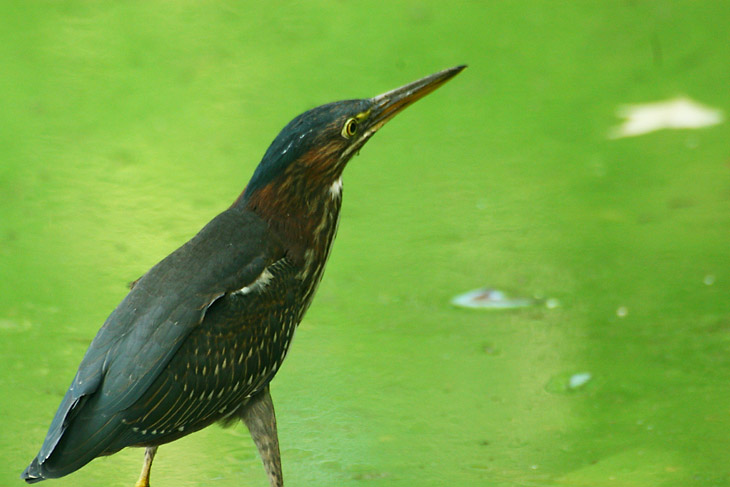
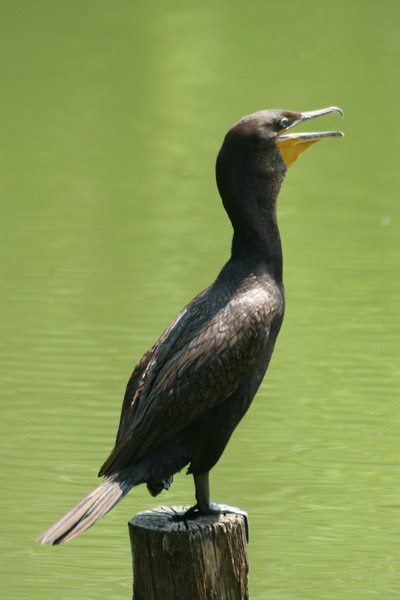 As
As 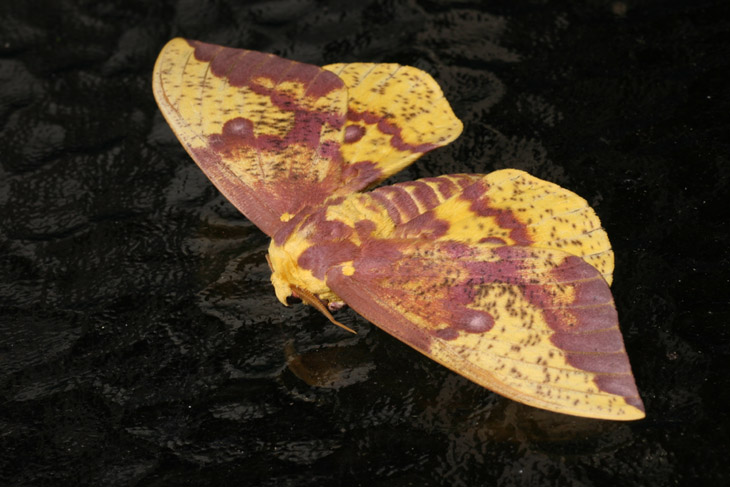

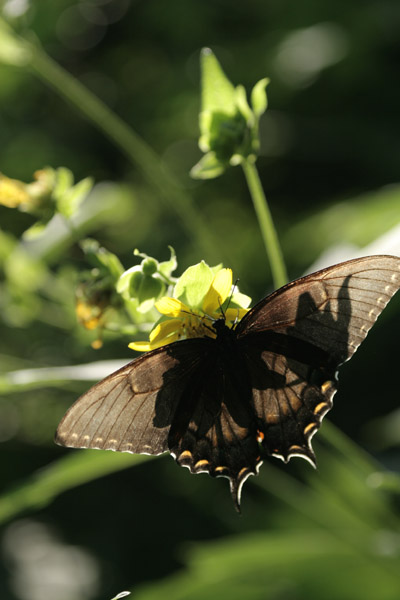 A few weeks back, an outing with a student was providing highly variable and scattered lighting conditions, but I took advantage of this to shoot a backlit
A few weeks back, an outing with a student was providing highly variable and scattered lighting conditions, but I took advantage of this to shoot a backlit  And finally, another outing produced this striking pair, handily, because I’d been telling
And finally, another outing produced this striking pair, handily, because I’d been telling  For today’s Monday color, we go back almost exactly five years (one day shy,) and over about eight or so kilometers, and turn mostly north, to the UNC Botanical Gardens and a butterfly, probably a
For today’s Monday color, we go back almost exactly five years (one day shy,) and over about eight or so kilometers, and turn mostly north, to the UNC Botanical Gardens and a butterfly, probably a